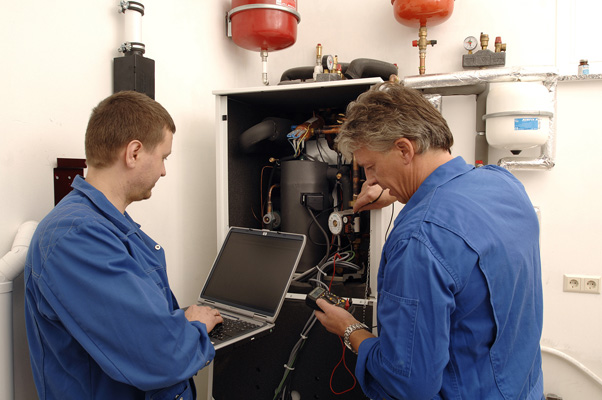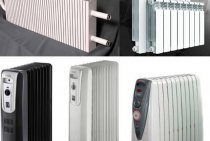5. Hot water system
hot water systems
water supplies are centralized
and local. Hot water supply
is to prepare hot
water in special water heaters,
which are installed in boiler rooms
or in heating stations.
Hot water supply
carried out in open and closed
schemes.
With open
hot water system
water is taken from the supply or return
heating mains. At hours
maximum water consumption hot
water is taken only from the return
pipeline, and during minimum hours
water consumption only from the supply,
to compensate for the cooling of the water
hours of minimum water consumption and,
thus ensure its normal
temperature. Maintenance of regulatory
hot water temperature
water supply is provided through
regulation of the amount of water entering
from the main supply pipeline.
To do this, the heat unit is equipped with
liquid thermostat (TRZh). By
in relation to the heating system hotter
water supply can be
parallel and series circuit.
With a parallel connection scheme
hot water from the outdoor heating system
the heat point can be divided into two
flow. One is fed into the hot
water supply, the other - for the needs of heating.
With a sequential scheme, water on
hot water needs are taken
from the return line of the heating system.
In St. Petersburg
usually used open
systems.
When closed
hot water system hot
water is obtained by heating cold
tap water in high-speed and
capacitive water heaters (boilers).
Maximum
hot water temperature in open
hot water systems should
be no higher than 75 ° C
and not lower than 60 ° C,
and in closed - 50-60 ° C.
hot water systems
water supplies come from the top or from
lower wiring, dead ends and
circulation. The disadvantage of dead ends
systems is that at the top
distributing water can cool down when
lack of water intake, and with lower
wiring provides insufficient
head. With circulation system
lay two risers, one of which
water-folding, and the other circulation.
Water heaters
and hot water systems
required at least once a year
check for density and subject
hydraulic pressure test
0.75 - 1 MPa (7.5-1.0 kgf / cm 2).
Shutdown systems
hot water supply for repair
should be carried out for a period of not more than two
weeks.
Twice a month
to check the functionality of the shut-off valve
and control valves of the hot
water supply needs to be slow
open and close all valves and
valves. Must be done once a month
checking the operation of automatic
thermostats (TRZH) and regulators
pressure.
In progress
operation must be monitored
no leaks in risers and piping
to water fittings and eliminate
causes of failure and
water leak.
Control questions
Dependent and
independent scheme of heat supply systems
buildings.
device and
purpose of the elevator.
Calculation procedure
heating surface area
devices with one-pipe and two-pipe
building heating systems.
Characteristic
heating appliances.
Scope of work for
technical operation of systems
heating.
open and closed
diagrams of hot water supply systems.
SNiP 2.04.05 - 91
Heating, ventilation and air conditioning.
Rules and Regulations
technical operation of housing
fund. Ed. N.M. Vavulo - M.
Military Publishing, 1998.
V.M. Svistunov,
N.K. Pushnyakov. Heating, ventilation and
air conditioning. Textbook
for universities. - St. Petersburg: Polytechnic, 2001.
engineering systems,
equipment of buildings and structures:
Textbook / E.N. Bukharkin, V.M. Ovsyanikov,
K.S. Orlov and others, ed. Yu.P. Sosnin. —
Moscow: Higher school, 2001.
Sample heating maintenance plan
In order for the equipment to serve for a long time and uninterruptedly, periodic monitoring and high-quality care are necessary for it. But sometimes there are situations when urgent intervention is necessary, and in order to carry out the next repair work, you need to know about the health of the entire system in advance.
Preventive inspection - is a necessary part of the maintenance of equipment, generating and distributing parts of the heating system
First of all, you should pay attention to the distribution part, since this part is the largest, it includes a pipeline, radiator batteries or collectors. In addition, malfunctions in connections, fittings or heating devices will cause problems when setting up the boiler.
Maintenance of the internal heating systems of the distribution network must be carried out independently at least once a year. It is necessary to start the inspection by checking the condition of the weld and other connecting elements. Water systems are checked for leaks, scale and rust. The thread is inspected and the degree of its tightness. It seems that the plumbing is constantly stable, but it is not.
Subjected to temperature changes, the metal either expands or contracts, and this cannot but affect the quality of the joints. The internal parts of pipes and radiators are also periodically inspected for deposits, rust or scale. For this, threaded connections are unpacked.
Maintenance of heating systems of private houses includes inspection of the chimney. It is necessary to light a folded newspaper or something similar, resembling a torch and partially sticking it into the pipe, check the draft, the serviceability of the sensors. Also, once a year, it is necessary to check the gas pipeline connections with soapy foam, whether there is a leak or not.
Start-up, prevention, testing of the heating system

Starting the heating system has its own characteristics for apartments with centralized networks and autonomous complexes. Pressure testing of central heating systems is carried out by heat supply organizations, usually after the end of the heating season. Residents will be notified of events.
After carrying out all technical measures, residents should conduct a visual inspection of the system components - pipelines, radiators, fittings, seals for leaks, fogging, and the like. Any appearance of water signals a future possible leak. Therefore, for security reasons, it is better to replace an unreliable element.
If there is a technical possibility, the owner of the apartment can independently remove and rinse the radiators. When starting the system, many recommend not to immediately turn on the radiator, but to direct the coolant in addition to it - along the bypass, if any. Turning on the battery too early can lead to excessive contamination of its internal surface - when starting up networks from highways, a large amount of sand, rust, dirt gets into the house networks.
Start-up of an autonomous heating system should be carried out at a positive temperature in the premises. As for flushing heating systems, different situations are possible here. The generally accepted rule states that the system must be flushed annually after the end of the heating season.
It is not always advisable to carry out an annual flush made of non-corrosive materials - polymers, copper, aluminum. Contamination of closed-type systems is minimal due to the absence of decomposition products of materials and a rare replenishment of the coolant volume. With such configurations of the heating complex, flushing should be carried out as the efficiency of the radiators decreases - this signals the formation of deposits.
Annual flushing is the business of every owner of a private house. It should be said that flushing the system always affects its efficiency only positively. Flushing of equipment is usually carried out through a connection to a cold water supply network - until the water is completely clarified. Flushing is required after the repair of individual elements. In case of serious pollution, operations are carried out on deep heating equipment.

After flushing, it is recommended to fill the system with coolant - this significantly reduces the corrosion rate. Filling heating with deaerated, chemically treated water or condensate at home is difficult - therefore, the system is most often filled with plain water.
Heat supply organizations check networks for density and strength on their own, regardless of apartment owners. The pressing pressure in this case varies from 6 to 10 kgf/cm 2 . Raising the pressure to such values is somewhat irrational.
The working pressure in autonomous complexes never exceeds the limit of operation of the safety valve - 3.0 kgf / cm 2. Exceeding this value will cause the device to operate, and an increase to 6 - 10 kgf / cm 2 most often leads to damage to the sealing materials of the joints, and even other network components - pipes, radiators.
Therefore, a hydraulic test is recommended to be carried out with the PC removed, the test pressure is not more than 1.5R slave = 4.5 kgf / cm 2. The specified pressure value is sufficient to detect critical leaks, but it is safe for the structural elements of the system. The crimping pressure should be increased smoothly, when the desired value is reached, a time interval of 10 minutes is maintained. This is followed by a visual inspection of the system. If leaks are found, they are repaired and the leak test is performed again.
Annual pressure testing of an autonomous system usually reveals leaks in connections, leaks in rubber, synthetic and other seals. When flushing and checking for tightness, the heating boiler should be cut off with fittings - operations with it are carried out separately.
The operation of the heating system implies the implementation of a number of mandatory actions on the part of the owner of the home. Their conscientious and high-quality, timely execution increases the efficiency of the equipment (while saving fuel), extends the life of the boiler, heating appliances, pipelines, and other elements.
Boiler room and ventilation system
Maintenance of the heating system includes:
in case of rusting or boiling of valves and taps, partial disassembly and processing of parts with an iron brush from all kinds of deposits is necessary
In addition, it is necessary to replace the seals and all kinds of seals, repack the threaded connections;
the circulation pump is disassembled for the purpose of cleaning or replacing coarse and fine filters;
it is also worth paying attention to the performance of monometers, spirotopes and other devices;
if liquid fuel or gas is used, the equipment must be checked for leakage;
chimney check;
in electric boiler equipment, once every two to three years, it is necessary to clean the heating elements from scale, as well as to carry out a probe that fixes the temperature. The ventilation system requires special attention
If air enters the room from the street, then you need to check the air injection system - the electric motor and ventilation shafts. Also, cases of settlement of the ventilation entrance by animals and birds are not uncommon.
The ventilation system requires special attention. If air enters the room from the street, then you need to check the air injection system - the electric motor and ventilation shafts. Also, cases of settlement of the ventilation entrance by animals and birds are not uncommon.

Boiler room
Operation of boilers and boiler equipment
To register a boiler house, the operating organization must issue an accounting card for the facility in the prescribed form. The accounting card is signed by the head of the organization and certified by its seal. When putting into operation a new boiler house, it must be registered in the state register no later than 20 days from the date of commencement of operation. Registered boiler houses are re-registered at least once every five years. The certificate of registration, complete with an accounting card, is kept by the operating organization and presented upon request.
According to the "Safety Rules for the Operation of Boilers and Boiler Equipment", the activities of organizations for the design, construction, operation, maintenance, commissioning of boiler rooms, and training of personnel must be carried out on the basis of licenses issued by the country's organizations. The development and implementation of new boiler equipment must also be coordinated with the country's organizational bodies.
Personnel who have been trained and have passed exams for knowledge of safety regulations during the operation of the heating system, the technology for performing work in the boiler room, who know how to use personal protective equipment (gas masks and life belts) and know how to provide first (first aid) aid should be allowed to work in the boiler room.
The examinations are administered by an examination committee with the participation of representatives of the Gosgortekhnadzor bodies of Russia. The results of the exam are recorded in the minutes. Those who fail the exam are retrained. Persons who have committed violations of safety rules and safety instructions must undergo an extraordinary knowledge test.
In each boiler room should be posted in prominent places:
- a diagram of the pipelines of the boiler room with the application of all valves, taps and valves, provided with instructions on the use of this valve;
- rules for stokers and firemen of boiler houses;
- table of water temperatures in boilers at various outdoor temperatures;
- daily schedule of fuel consumption depending on the outside temperature;
- work schedule of stokers and stokers;
- telephone numbers of the emergency team, locksmith on duty, ambulance, fire department, head of the engineering and technical service of the hotel;
- inner order rules.
The personnel servicing the hotel heating system must know the scheme and internal arrangement of all the equipment of the system, the rules and norms of its technical operation, ways to eliminate technical problems, methods of temperature control.
The technical operation of the central water heating system in hotels is aimed at ensuring the efficient and uninterrupted operation of the system and is planned. To achieve trouble-free operation of the heating system, it must be operated in strict accordance with the Rules and Regulations for the Technical Operation of Residential and Public Buildings. These rules provide for a system of preventive maintenance, including: technical inspections, maintenance, current and major repairs, compliance with the norms and rules for the technical operation of the boiler house building, thermal and other equipment, pipelines, appliances, etc.
Inspection of the entire heating system is carried out by a special commission at least twice a year: in spring and autumn. The boiler plant is inspected by the boiler supervision inspector once a year. On a monthly basis, an equipment repairman inspects devices located in attics and basements, weekly - boilers and boiler equipment, and emergency areas - once every two days. Urgent repairs of the heating system, registered in the application log, are performed by a locksmith, and in case of serious accidents, a special team is responsible for their elimination. At the end installation or overhaul the central water heating system is being commissioned. For this, hydraulic and thermal tests of the heating system are carried out.
Calculated values of coolant flow
The nature of the use of fuel cells for hot water supply during the day is not constant. The day can be divided into 3 characteristic periods of water consumption:
Daytime - from 8 am to 6 pm;
Evening - from 19 to 23 hours;
Night - from 24 to 6 hours.
The time intervals between the selected characteristic periods of heat consumption differ in the transitional values of heat consumption.
The heat flow to the local DHW system of a residential building during the day consists of the heat flow to the DHW itself, to heat losses in the DHW system and heat costs for heating bathrooms:
Daily period - Q h \u003d Q hm + Q ht; (5)
Operation of a water heating system is a set of mandatory measures necessary for the efficient, safe operation of equipment and heating pipelines. There are various versions of instructions for maintenance, control and prevention of heating - but they are most focused on outdated configurations of the heating complex with elevator units, steel pipes and valves.
The material of our publication provides an overview of the algorithm for operating individual heating systems for private houses, centralized apartment heating.


